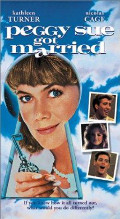
Directed by
Francis Ford Coppola
103 minutes
Rated M
Reviewed by
Bernard Hemingway

Peggy Sue Got Married
Visiting the much-explored theme of time travel, Coppola’s film is the story of Peggy Sue Bodell (Kathleen Turner), an unhappily married 42 year old mother of two on the cusp of a divorce who faints at her high school ‘Class of 1960” reunion and wakes up to find herself a teenager again. Peggy Sue gets a chance to go back to where it all started to come undone for her.
Tapping into an idea which will resonate with most adults, the “what if” scenario, the film is very similar in theme to Spielberg’s Back To Future which came out the previous year. But whereas that film, as the title indicates, played cleverly with the time travel concept, taking great care to ensure that the logic of narrative which requires that the future is guaranteed by the past, Coppola's film fudges the issue, substituting in its place a winsomely poignant approach. The result is completely illogical as it allows Peggy Sue to intervene in the past yet there to be no consequence for her future.
This is most apparent in Peggy Sue's relationships with Richard (Barry Miller) to whom she reveals her trans-temporal secret and gives various tips about the future but who has no memory of her in the film’s present and Michael (Kevin J. O’Connor) on whom she has a crush in the past and takes the opportunity to sleep with the second time around and then writes a book about it (which miraculously arrives the very day that Peggy has her fainting spell. Perhaps the most obvious failure of logic is when Richard pushes Peggy Sue into a path of an oncoming fire engine in order to prove whether or not she is from the future and she jumps out of the way.
Whilst Peggy Sue Got Married does not have the wit or rigour of Spielberg's film it is more rewarding to see Peggy's journey in the past not as sci-fi but rather as a dream, the film being an exploration of the way that hopes and fears, aspirations and mistakes conspire to take our lives in directions we never could have anticipated it is still a film with charm.
Not a little of this is due to Turner’s Oscar-nominated performance (on a sympathy vote the Oscar went to Marlee Matlin in Children Of A Lesser God) in a difficult role which she pulls off superbly, not by acting ditzy as Jamie Lee Curtis did in Freaky Friday (2003) but by capturing an unaffected innocence, so much so that we see her as do her peers, who are completely oblivious to her otherwise evident maturity.
Unfortunately Coppola’s nephew, Nicolas Cage, is as awful as Turner is good. He spends most of the film as a goofy teenager with a pompadour and, for no apparent reason, a grating nasal twang (he based his character's voice on the character, Pokey, of the 1956 television program "The Gumby Show"). He is just as ill-fitted as Peggy Sue’s middle-aged husband. One might also question why a way-too-old Helen Hunt was cast as Peggy Sue’s daughter.
Coppola was the third director attached to the project (and the female lead was originally given to Debra Winger) taking over from Penny Marshall who was fired after three weeks in the director's chair. Apparently the director wanted to replace Cage but the latter convinced him not to. It was a big mistake on Coppola's part for in every other respect, Peggy Sue Got Married has good claim to be one of the most touching time travel movies ever made.
Want something different?





